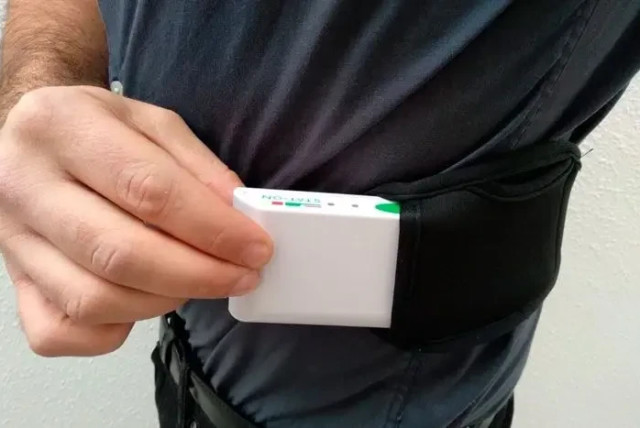Israel introduces home testing for Parkinson's monitoring

The new home-based test enables Parkinson's patients to monitor their motor condition and disease symptoms, refining existing medical treatment and alleviating symptom burden.
For the first time in Israel, a home-based monitoring test for Parkinson's disease has been introduced. The test will enable Parkinson's patients to monitor their motor condition and disease symptoms at home, thereby refining existing medical treatment and reducing symptom burden.
Parkinson's disease is a chronic, progressive, and incurable neurological disorder that affects nerve cells in the brain that produce dopamine, which is essential for transmitting signals from the brain to the central nervous system. In Israel, an estimated 30,000 Parkinson's patients live, with approximately 2,500 new patients diagnosed each year.
Patients with the disease receive tailored drug therapy for motor symptoms such as tremors, rigidity, slowness of movement, and imbalance, as well as non-motor symptoms including constipation, sleep disturbances, orthostatic hypotension (a drop in blood pressure upon standing), and more.
The drug regimen for Parkinson's is personalized, aiming for better management of disease symptoms. Treatment typically involves a combination of drugs with different mechanisms of action. However, finding the balance between symptom management and multiple drug intake throughout the day is often challenging and requires an understanding of the patient's function, disease duration, dominant symptoms, and more.
Assisting in the precision of patient drug dosage
STAT-ON, a home-based tracking device based on AI technology, has recently been launched in Israel. Weighing 80 grams, the compact device is attached to the patient's waist belt for a week and continuously monitors motor symptoms. At the end of the process, a report is generated, providing both patients and treating physicians with an accurate snapshot of the disease's status. For patients using medication, the report can analyze whether they adhere to the treatment regimen according to the doctor's instructions, identify potential dosage fluctuations, and adjust medication precision based on the patient's condition.
The new home-based monitor test allows treating physicians to gain a comprehensive understanding of the patient's condition throughout the day, not just during clinic visits. It enables more accurate adjustment of medication dosage and type, thereby contributing to the improvement of patients' quality of life.
"As treating physicians, the results of the home monitor test are significant to us," says Professor Sharon Hassin, Director of the Movement Disorders Institute at Sheba Medical Center. "When a patient comes to the clinic, I want to know their condition throughout the day, from morning to night. Often, the patient's self-report does not fully reflect their actual condition. The monitor provides an objective measure of their mobility and activity in their natural environment and, most importantly, whether they take medication at the right times and maintain balance throughout the day."
"After the test, patients have a better understanding of the disease"
Professor Hassin adds: "From my experience, I almost always gain insights as a treating physician from the test results regarding more precise and evidence-based instructions, and the patient also understands better what they need to do. The better the patient understands their condition and what they need to do, the better their condition will improve, and they will have a better grip on life."
"Sometimes I realize that a patient is on too low a dosage of medication, and then I need to increase the dosage or better distribute the medication throughout the day," she says. "All of these things can provide the patient with more hours of activity per day."
"The device allows continuous and objective monitoring that does not rely on the patient's memory, which sometimes presents a better or worse picture than the actual situation," says Dr. Nirit Lev, Director of the Neurology Department at Meir Medical Center. "Monitoring is not treatment, but it is part of the treatment process, and then we can adjust the treatment more effectively. From my experience with my patients, after the test, they have a better understanding of how the disease affects them."
"This is the basis for decision-making, therapeutic changes, or understanding that the treatment itself is not bad, and it's just the patient's fear of entering an OFF state that causes them to take unnecessary doses," Dr. Lev explains.
"To know when patients are in an ON state and when they are in an OFF state"
"For patients at a crossroads, this tool can definitely help, and it can lead to new decisions and necessary changes," adds Dr. Tzvia Faye Carmon, Deputy Director of the Movement Disorders Institute at Sheba. "Test results also assist in designing an appropriate occupational therapy plan for Parkinson's patients. Through the home monitor test report, we can understand when patients are in an ON state and when they are in an OFF state, and accordingly, tailor a weekly exercise regimen to their capabilities. For example: when is it advisable to go shopping, see grandchildren, and the like – all the important things to do when they are in an ON state rather than an OFF state," says Ilanit Baum Cohen, Occupational Therapist at Sheba Medical Center.
The device has been in use for the past two years in several European countries. It is regulatory approved for use in 16 countries, including Israel, and has also received a recommendation from the UK's National Institute for Health and Care Excellence (NICE).
The test is private and not subsidized by health funds. Its cost ranges between NIS 1,500-2,000, including home visits to the patient. Patients with private health insurance, which includes a diagnostic component, can request reimbursement for disease status diagnosis (with self-participation deduction).
Jerusalem Post Store
`; document.getElementById("linkPremium").innerHTML = cont; var divWithLink = document.getElementById("premium-link"); if (divWithLink !== null && divWithLink !== 'undefined') { divWithLink.style.border = "solid 1px #cb0f3e"; divWithLink.style.textAlign = "center"; divWithLink.style.marginBottom = "15px"; divWithLink.style.marginTop = "15px"; divWithLink.style.width = "100%"; divWithLink.style.backgroundColor = "#122952"; divWithLink.style.color = "#ffffff"; divWithLink.style.lineHeight = "1.5"; } } (function (v, i) { });

